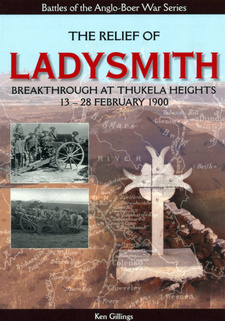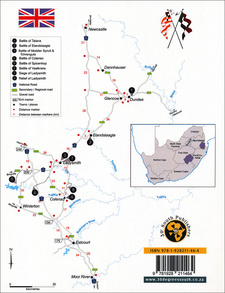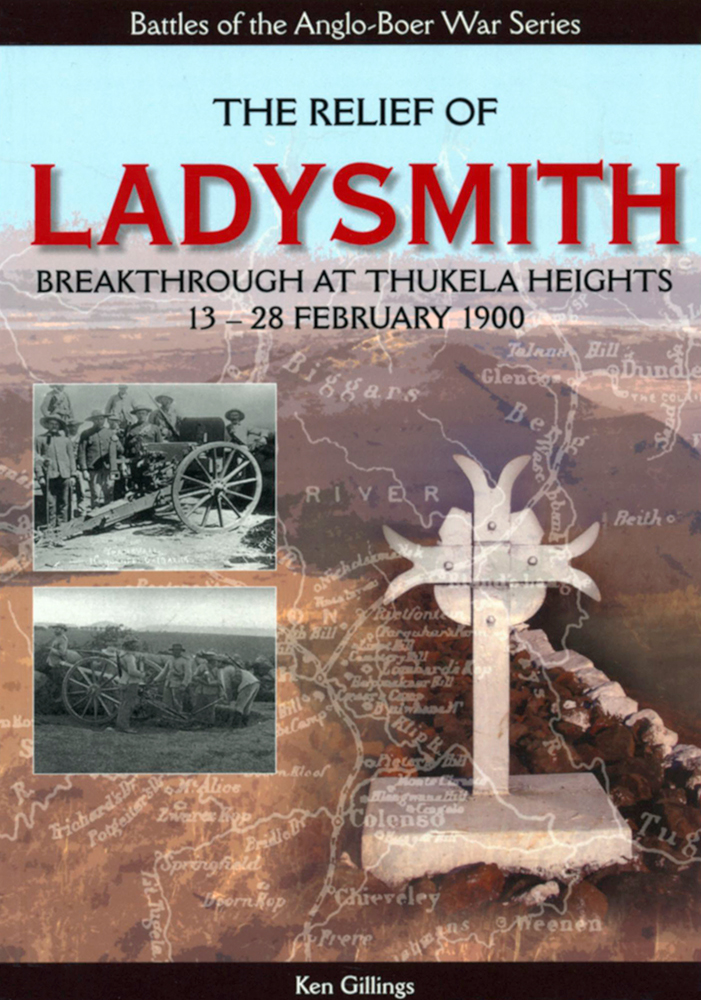The Relief Of Ladysmith, by Ken Gillings

The Relief Of Ladysmith, by Ken Gillings. The Anglo-Boer War Battle Series. Publisher: 30 Degrees South Publishers (Pty) Ltd. 2nd edition. Johannesburg, South Africa 2014. ISBN 9781928211457 / ISBN 978-1-928211-45-7

Overview map of the relief of Ladysmith during the Anglo-Boer War.
Ken Gillings, in the beginning of The Relief Of Ladysmith, describes the following situation:
Background
By the time that the Battle of the Thukela (or Tugela) Heights had commenced on the 12th February 1900, the 114-day Siege of Ladysmith was in its fourth month. General Sir Redvers Buller VC had made four attempts to relieve Gen Sir George White VC and the Ladysmith garrison: at Colenso, on the 15th December 1899, along the iNthabamnyama on the 20th/21st January 1900, at Spioenkop on 23rd/24th January 1900, and at Vaalkrans between the 5th and 7th February 1900. All three attempts had been unsuccessful, and the British casualties had been high. After the battle of Vaalkrans, Buller withdrew his troops to Chieveley, a few km south of the village of Colenso, which he reached on the 10th February 1900. He maintained contact with Field Marshal Lord Roberts VC, who was about to commence his great flank march, which would result in the relief of Kimberley, and later, his advance on Bloemfontein. The situation in Ladysmith was deteriorating at an alarming rate for the inhabitants of the town; enteric fever was taking its toll, food was becoming scarce, and the morale of the troops and the civilian population was beginning to suffer. The Boers had, meanwhile, observed the British withdrawal from the upper Thukela River, and began to strengthen their positions along the high ground known as the "Tugela Heights". These extended from below Rooikop (also known as Vertrekberg) to Railway Hill, and later as far as Aasvoelkrans. They also occupied much of the high ground east of the village of Colenso, including Hlangwane, Naval Hill and Fuzzy Hill, as well as Green Hill, Monte Cristo and Cingolo. The southernmost extremity of their line was based on Hussar Hill. At this stage, their numbers totalled some 3 000 along the north bank of the Thukela river, and approximately 1 500 along the south bank. The former had, in the main, occupied the same trenches and breastworks which had been constructed prior to the Battle of Colenso on the 15th December 1899. They had been well prepared, were deep enough to stand in, and in many instances they were sandbagged and camouflaged. They had been improved upon on the orders of Gen Louis Botha after the battle of Colenso. Botha had been appointed Acting Commandant General after Commandant General Piet Joubert had been thrown from his horse during the Boers' southward thrust in November 1899.
The options available to the British
After failing to break through the Boer line along the upper Thukela River, Buller favoured an attack from the east (in the Weenen area). This would have involved a long march via broken countryside, and accordingly, several alternatives were proposed to him by his staff. The most acceptable was a wide turning movement in an eastward direction.
Preliminary British south bank movements -12 to 14 February 1900
On Monday 12th February 1900, Colonel the Earl of Dundonald's Mounted Brigade made a successful reconnaissance of Hussar Hill (named after an action between the Boers and a picket of the Hussars six weeks earlier). Buller believed that this feature would be a good vantage point from which to observe the Boers' left flank. Dundonald left Stuart's Farm at 08h00 on the 12th February 1900 with 700 mounted troops, the 1st Royal Welsh Fusiliers, 64th Battery RFA and a Maxim Battery. He occupied Hussar Hill with little opposition from the Boers. The Boer sentries on the hill fired at Dundonald's troops before running for the shelter of the dongas (dry water courses) to the north, east and west of the hill. [...]
This is an excerpt from The Relief Of Ladysmith, by Ken Gillings.
Title: The Relief Of Ladysmith
Subtitle: Break Through At Thukela Heights 13-28 February 1900
Author: Ken Gillings
Series: The Anglo-Boer War Battle Series
Publisher: 30 Degrees South Publishers (Pty) Ltd.
2nd edition. Johannesburg, South Africa 2014
ISBN 9781928211457 / ISBN 978-1-928211-45-7
Softcover, 15 x 21 cm, 48 pages, 25 b/w photos and maps
Gillings, Ken im Namibiana-Buchangebot
The Relief Of Ladysmith
The relief of Ladysmith and the break through at Thukela Heights during 13-28 February 1900.

